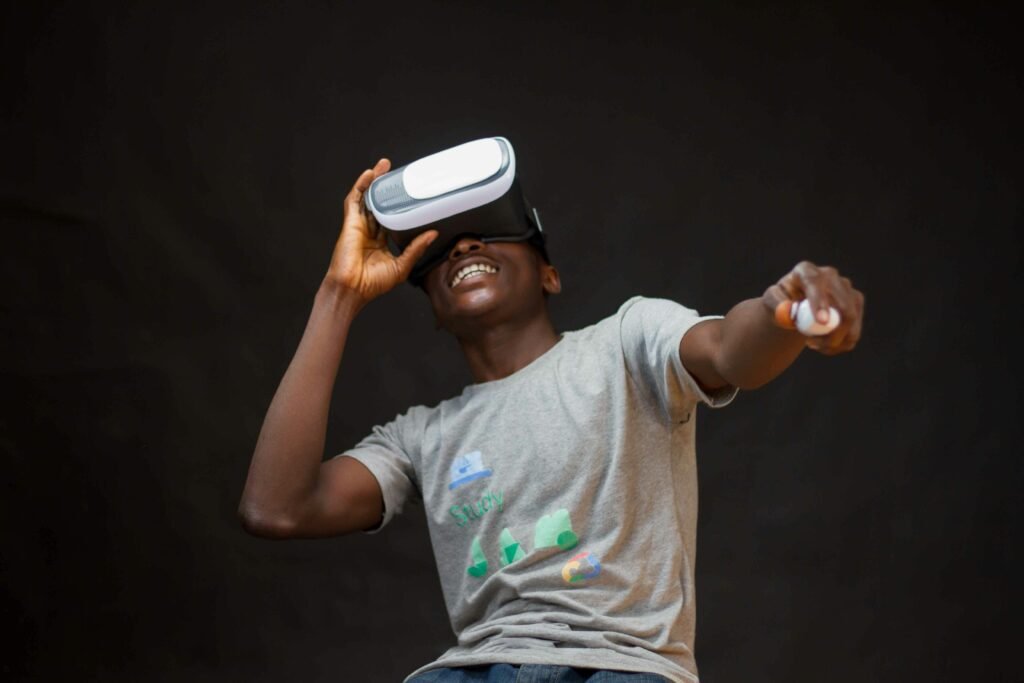Introduction: VR’s Turning Point in American Gaming
A decade ago, Virtual Reality was mostly a tech demo, a futuristic idea that seemed out of reach for everyday consumers. The headsets were clunky, the visuals grainy, and the price tags intimidating. Fast forward to today, and VR has matured into a vibrant part of the gaming ecosystem, thanks largely to the U.S. gaming industry’s relentless push to refine hardware, improve software, and make immersive experiences accessible.
From Meta’s Oculus Quest series redefining standalone VR to Sony’s PlayStation VR2 pushing console-based immersion, American-led innovation is not only making VR better it’s making it mainstream. Esports events now include VR competitions, VR arcades are popping up in malls and entertainment districts, and developers are creating games so realistic they blur the line between reality and imagination.
Despite all the advances in technology, many of us still play games like we did a decade ago – on a screen with a hand-held controller, says the BBC
The U.S. gaming market is uniquely positioned to drive VR adoption for three reasons:
- Scale – It’s the largest gaming market in terms of revenue and player base in the Western hemisphere.
- Technology Infrastructure – From Silicon Valley R&D labs to AAA game studios, the resources are immense.
- Culture of Early Adoption – American gamers often embrace new tech trends faster than their global counterparts.
Market Momentum: Why the U.S. Is the Engine of VR Growth
The numbers tell a compelling story. The global VR gaming market, valued at around $32.5 billion in 2024, is forecast to hit $109.6 billion by 2030. North America alone contributes a significant share, with the U.S. leading both in revenue and innovation.
- Rapid User Growth: About 77 million Americans use VR today, and that number is expected to cross 91 million by 2028.
- Steady Hardware Uptake: VR headset shipments in the U.S. have steadily risen, with standalone devices like the Quest 3 outselling tethered PC-based systems.
- Consumer Spending: The average U.S. VR gamer spends more on content annually compared to global averages, driving studios to invest more heavily in immersive titles.
This growth is not just about gamers buying new toys. It’s about creating a sustainable ecosystem where hardware, software, and community engagement fuel each other.

Hardware Innovation: U.S. Companies at the Forefront
While VR gaming is a global effort, many of the most significant breakthroughs originate in the United States.
1. Meta’s Prototypes: Pushing the Limits
Meta’s “Tiramisu” prototype is a resolution monster 90 pixels per degree with triple the contrast of Quest 3. While its 33×33° field of view is small, it’s designed for ultra-sharp visuals, potentially redefining visual fidelity for simulation-heavy games.
The “Boba 3” takes a different approach: a massive 180° horizontal and 120° vertical field of view, paired with 4K×4K per-eye resolution. It’s all about wide, cinematic immersion ideal for multiplayer Virtual Reality arenas and open-world exploration.
2. Sony’s PlayStation VR2: Console Immersion
Sony, though Japanese in origin, operates a massive R&D and market presence in the U.S. Its PS VR2 offers OLED HDR displays, inside-out tracking, and adaptive triggers, bringing a premium VR experience to console gamers without requiring a $2,000 PC setup.
3. Apple Vision Pro: The Crossover Device
Apple’s entry into the space is less “gaming headset” and more “spatial computer.” Still, its ultra-high-resolution micro-OLED screens, eye tracking, and mixed reality capabilities hint at a future where VR gaming could merge with productivity and entertainment in one sleek device.
Real-Life Integration: Where VR Gaming Meets Everyday Experiences
U.S. gaming companies aren’t just making VR hardware they’re integrating VR into the broader entertainment and social experience.
- Location-Based Virtual Reality: Venues like The Void and Zero Latency offer warehouse-scale multiplayer VR adventures. Imagine walking through a Star Wars mission with friends, feeling blaster recoil and smelling the burning metal around you.
- Esports in Virtual Reality: Competitive VR games like Echo VR and Onward are carving out niches in the esports scene, with tournaments streamed to thousands of viewers.
- Social Platforms: Horizon Worlds, Rec Room, and VRChat have evolved into hangout spaces where people attend concerts, comedy shows, and even business meetings, entirely in VR.
Challenges Holding VR Back
For all its promise, VR is still fighting uphill battles.
- Motion Sickness – Despite improvements, some players still feel nauseated after extended sessions.
- Hardware Cost – While prices are dropping, high-end VR still demands investment.
- Content Gap – Players want more “must-play” VR titles akin to Half-Life: Alyx.
- Social Adoption – Wearing a headset still feels isolating compared to console or PC gaming.
Interestingly, these challenges are exactly where the U.S. gaming industry’s strengths lie rapid prototyping, aggressive content creation, and marketing that can shift public perception.
FAQs
1. How big is the VR gaming market in the U.S.?
It’s worth around $3.6 billion as of 2024 and projected to reach $5.5 billion by 2035.
2. How many Americans use Virtual Reality today?
Roughly 77 million, with steady growth expected for the next decade.
3. Which U.S. gaming companies lead VR innovation?
Meta, Valve, Epic Games, Activision Blizzard, and Unity are top players.
4. What is location-based VR gaming?
High-end VR experiences in dedicated spaces, often with physical props and full-body tracking.
5. Why are smart glasses gaining traction?
They offer lighter, more socially acceptable wearables that blend AR and VR features.
6. How is gaming influencing VR outside of entertainment?
Training simulations, medical procedures, military drills, and education benefit from VR originally designed for games.
7. Why hasn’t VR gone fully mainstream yet?
Hardware comfort, content variety, and social acceptance still need to improve.
8. What innovations are coming next?
Higher resolution headsets, better field of view, wireless low-latency streaming, and photorealistic avatars.
9. How important is social VR?
Extremely players crave interaction as much as gameplay in VR spaces.
10. Will VR be mainstream in five years?
Most industry analysts say yes if the next generation of devices nails comfort, price, and killer apps.
Key Takeaways
For Gamers:
- Explore location-based Virtual Reality for premium experiences without owning expensive hardware.
- Keep an eye on cross-platform VR titles to connect with a broader player base.
For Developers:
- Focus on “social stickiness” in games to retain players long-term.
- Build content optimized for both high-end PCs and standalone headsets.
For Businesses:
- Use VR as a branding tool sponsored VR events and branded in-game spaces are emerging marketing frontiers.
- Watch AR-VR hybrids, as smart glasses may become the gateway to full VR adoption.
The Human Side: Why This Matters
VR in gaming isn’t just about pixels and processors. It’s about emotional connection about standing next to a friend in a virtual forest and feeling like you’re truly there. It’s about training for a real-world job in a risk-free environment. And it’s about redefining entertainment so that it’s not just watched, but lived.
The U.S. gaming industry understands this balance between technology and emotion. That’s why it’s not just shaping VR it’s shaping the way we’ll experience digital life in the decades ahead.
To read more about AR and VR, Read this!
#VRGamingEvolution #USGamingLeadsVR #FutureOfVR #ImmersiveGaming #SmartGlassesRevolution #MetaTiramisu #AppleVisionProGaming #LocationBasedVR #VRCommunity #NextGenVR
